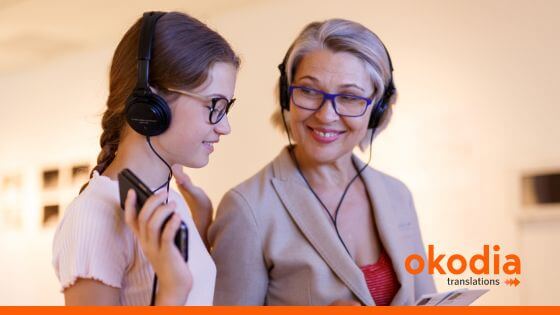Visiting museums is undoubtedly an educational pastime that allows us to both learn about a culture and understand society better. Going to a museum also means participating in communication since there are lots of written explanations for the works on display. These, in turn, need to be translated in different ways to make them accessible to everyone. Audio description in museums is one such translation method, and an increasingly valuable one. This in turn is increasing the demand for UK translation services. Read on and find out more about this specialist area!
How audio description in museums began
Museums have become increasingly popular in recent decades as interest has grown in disseminating their cultural heritage. This strong trend made people start thinking about how to increase accessibility for people traditionally excluded from this type of event due to visual disabilities. But there is no need to panic! The solution is a simple one, namely using audio description services in museums.
Audio description in museums therefore arose as an essential communication tool to bring the culture of museums closer to people with visual disabilities. It is a combined effort involving art educators, museologists, publicists, interpreters and professional translators. An extremely professional team is essential in creating an incredible experience for the audience. However, this tool can be used more widely than just for people with disabilities since it enriches everyone’s experience.
How is museum audio description recorded?
First of all, we should remember that this type of translation provides specialist information about the museum itself. Audio description recordings in museums result in files of oral narrations which not only describe the objects in the museum as stand-alone pieces, but also provide information on their historical-artistic background and on the layout of the space and their relationship with other pieces in the museum.
Audio description can be defined as the result of an intralingual translation process in which images are translated into words. However, it can also be defined as an interlingual translation process when we return these results in other languages. As is the case for any type of translation, creating an excellent audio description involves analysing what is being audio described. This is absolute essential and requires an exhaustive documentation process.
Technology also plays a very important role in this area, since it is thanks to technology that recorded audio descriptions can be made available to users in a variety of formats, such as mobile guides, on museum websites or even in applications that visitors can download to their devices.
How to make a museum accessible
Audio description in museums consists of the use of a set of sound techniques so that the visually impaired user receives the message in a way which is as similar as possible to how a sighted person would receive it. Some of the information that must be mentioned and considered to make an object accessible are the following:
- 1. Information from the labels
- 2. Description of the environment
- 3. Theme
- 4. Information on the historical, social and artistic background
- 5. Mention and explanation of the technique and material
- 6. Accurate language
- 7. Use of similes and analogies
- 8. Creatively used sound effects
- 9. Touch materials, such as raised images
This last point will create an immediate experience for the visitor as direct touch is the best way to explore an object. However, this is not sufficient on its own and touch materials must always be used jointly with a verbal narrative to create the desired effect for the audience.
The future of audio description in museums
Audio description in museums seeks to create a memorable museum experience that goes beyond simply passing on knowledge. While there is still a long way to go, efforts are being made to make museums more accessible and thus promote the connection between accessibility and culture.
At Okodia, our translation agency in London wants audio-visual culture to always come with high quality accessibility to guarantee the right to enjoy cultural events and leisure on equal terms.
Thanks to technological progress and the recent emergence of audio describers, the range of accessibility services is increasingly broad, convenient and suitable for achieving this purpose. The audio-visual translators at Okodia UK have the ability to combine all the guidelines and make the best decisions to turn museums into spaces that can be enjoyed by all audiences. Do you want to create a more accessible world?













